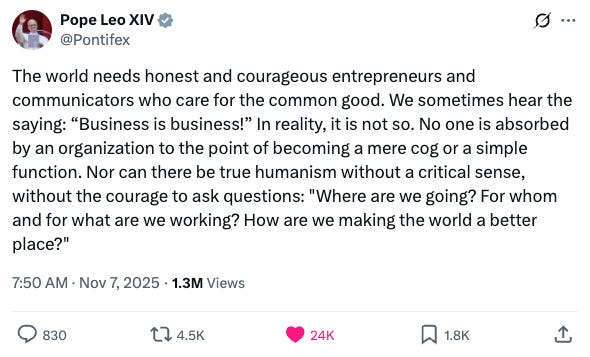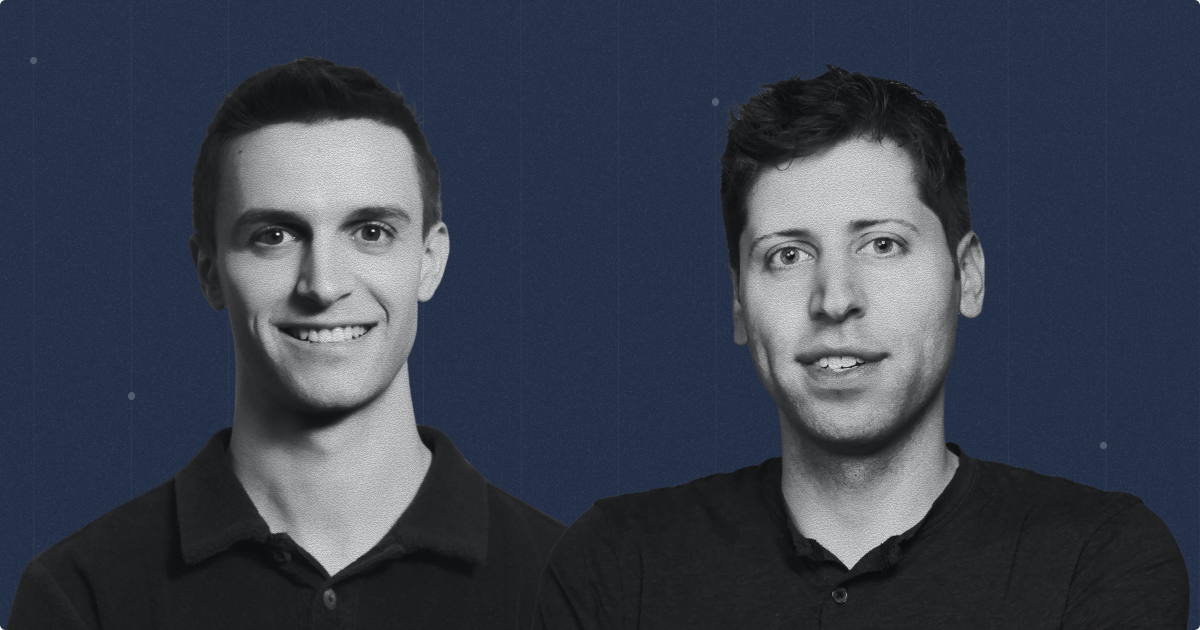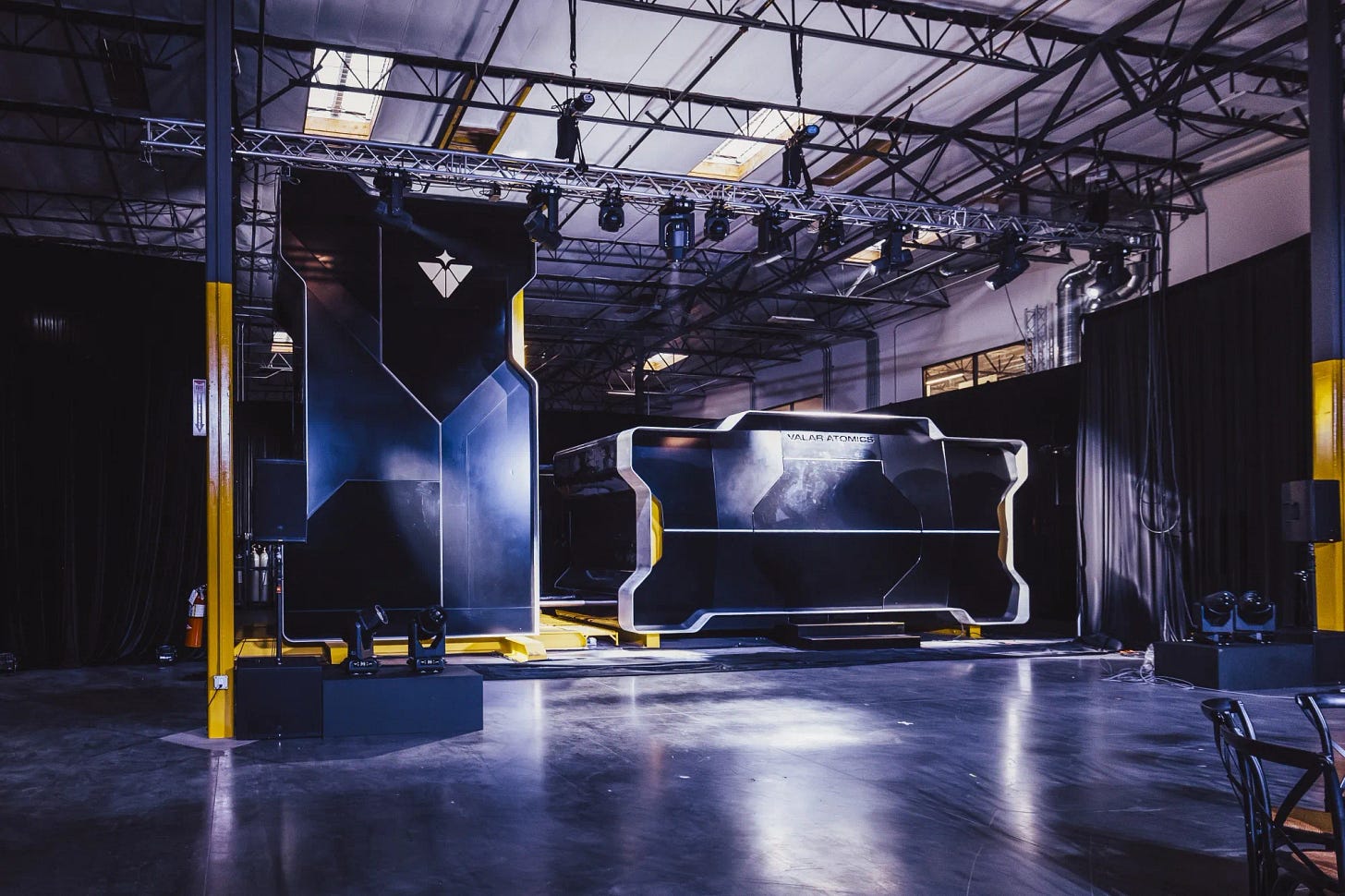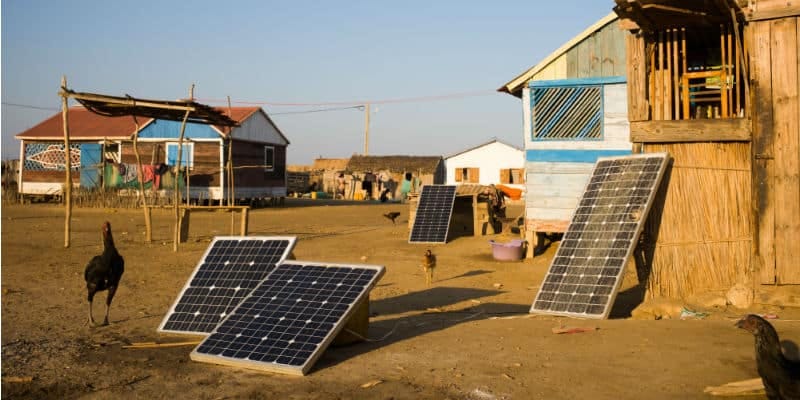Weekly Dose of Optimism #170
Episteme, Terranova, Valar Atomics, Elon's Factories, Blue Origin + Solar Two Ways
Hi friends 👋 ,
Happy Friday!
Pope Leo XIV, the American Pope, the Villanova University graduate, the White Sox fan, blessed the timeline with a number of tech-related tweets this week, including this one, which asks entrepreneurs to ask, “How are we making the world a better place?”
That phrase - “making the world a better place” - has become a trope, often used ironically in association with gambling apps and infinite scroll feeds. But there are a ton of entrepreneurs and scientists doing just that, and our job here at the Weekly Dose is to be the communicators who spread that good word. This week, for example, we have a startup trying to save cities from floods, a new lab to fund ambitious research, funding for cheap, safe, abundant energy, factories for batteries and rockets that might transport humans to other worlds, a Blue Origin booster landing, and solar in Africa.
We need to get Pope Leo subscribed to the Dose.
Let’s get to it.
Today’s Weekly Dose is brought to you by… WorkOS
Bot attacks are evolving. Is your app ready?
Modern bots behave like real users. They execute JavaScript, rotate IPs, and solve CAPTCHAs with AI. Traditional detection tools can’t keep up.
WorkOS Radar stops abuse at the source. Just one API call blocks bots, brute force attacks, and free trial abuse without slowing down real users.
Secure your app today with WorkOS Radar.
(1) Altman And Masa Back a 27-Year-Old’s Plan to Build a New Bell Labs Ultra
From Ashlee Vance for Core Memory
“It’s a broad range of disciplines,” said Priyamvada Natarajan, the chair of the Department of Astronomy at Yale and an advisor to Episteme. “It’s AI, energy, materials, novel battery systems and new kinds of superconductors. It’s inspired by Bell Labs or Xerox PARC but adapted for today’s scientific milieu. I think that’s what makes it a new kind of accelerator.”
One of the things that people in tech call for most often, second only to Manhattan Projects for X, is a modern version of Bell Labs or Xerox PARC, those talent-dense corporate research labs that invented the transistor, Unix, solar panels, the C programming language, Information Theory, the laser, the graphical user interface, ethernet, laser printing, object-oriented programming, and much much more.
Part of the challenge, though, is that doing it really well requires an infinite cash machine, like a telephone or printer monopoly, and at least some commercial incentive. Google is probably the closest thing we have today.
There are other infinite cash machines, though, two of the most famous of which are SoftBank founder Masayoshi Son and OpenAI founder Sam Altman, both of whom have backed Episteme.
Episteme, a newly founded research organization led by 27-year-old CEO Louis Andre, aims to create a modern-day Bell Labs or Xerox PARC for breakthrough scientific research. Based in San Francisco, Episteme addresses a fundamental problem that science. “Many of the world’s brightest minds in academia spend most of their time writing grants, managing bureaucratic overhead and publishing papers instead of pursuing their real work,” Ashlee Vance writes. “Meanwhile, venture-backed start-ups often come with near-term financial pressures that do not give the biggest, riskiest ideas the needed runway to flourish.”
The company’s model provides selected scientists with competitive salaries, equity ownership in Episteme, and full lab resources to eliminate fundraising pressures. Starting with 15 scientists in energy, computation, and neuroscience disciplines, the organization has identified 2,400 researchers it wants to recruit globally. One early recruit is Ben Angulo from Harvard’s Church Lab, who will focus on gene and cell therapies.
Episteme plans to help its researchers productize whatever they come up with in the lab, with support services on IP, hiring, tax issues, and more: “the hope is that products produced by the scientists make Episteme self-sustaining.”
I love the markets. The current system for doing science is cracking, which opens up an opportunity for people to try to come in and do it better. We hope to cover the many inventions and companies that come out of Episteme in the coming decades right here in the Dose.
(2) Terranova Raises $7M to Build Terraforming Robots for Flood Defense
Laurence Allen, CEO of Terranova
We are lifting cities out of flood zones using underground injection. Flooding is a multi-trillion dollar U.S. national security problem and this funding will get us to market with the first solution.
For as long as humans have walked the earth, we have been at the mercy of the water. Even with improved warning systems and flood defenses, flooding causes nearly $100 billion in economic damage, takes thousands of lives, and displaces millions more each year.
Now, humanity has a new way to rise above the floods.
Terranova, founded by Laurence Allen, has raised $7 million led by Congruent Ventures and Outlander VC to develop autonomous terraforming robots that combat flooding by lifting cities out of flood zones using underground injection technology.
The company’s approach injects a wood slurry deep underground, gradually raising the surface to offset subsidence or create elevation, with no surface disturbance and permanent protection for infrastructure and wetlands. Using shipping-container-sized pumping units and tracked robotic injectors, Terranova’s AI-powered software combines geological data to determine precise injection points and volumes with a SimCity-like interface allowing city planners to simulate projects before deployment.
The company claims it can lift 240 acres by four feet for approximately $92 million, a fraction of traditional solutions like seawalls (which can cost up to $900 million), making it viable for areas experiencing gradual subsidence, such as San Rafael, California, where some neighborhoods have dropped nearly a meter.
Check it out on their very cool website.
(3) Nuclear Startup Backed by Luckey, Lockheed Director Raises $130 Million
From Lizette Chapman for Bloomberg
The Hawthorne, California-based startup began construction in September in Utah on its first reactor and says it’s on track to demonstrate it can produce 100 kilowatts of thermal energy by July 4. Eventually, the company plans to mass manufacture small modular reactors and cluster them at so-called gigasites, where they will help power artificial intelligence data centers, industrial manufacturers and other customers.
We are big fans of Valar Atomics and its founder Isaiah Taylor here at Not Boring. Isaiah was one of the most thoughtful guests Julia and I hosted on Age of Miracles and I kicked off The Electric Slide with his insight that “There are only really three pillars to anything around us, as far as consumable goods. We’ve got energy, intelligence, and dexterity.”
Doubted throughout his journey because he didn’t have a conventional nuclear engineering background, was building Valar in the Gundo, and because he set ridiculously ambitious timelines and goals, Isaiah has remained focused on the task at hand. Now, he has an extra $130 million to put towards the task.
This week, Valar announced a new round of funding from Snowpoint Ventures, Anduril founder Palmer Luckey, and others, and reconfirmed its goal of going critical with a 100 kilowatt reactor in Utah by America’s 250th birthday on July 4, 2026.
And you know what, I think they just might pull it off.
(4) Elon Builds Two New Factories (and the Factories are the Product)
From Tesla and Dima Zeniuk
That’s our GigaBay. So we’re expanding integration to produce 1,000 Starships per year. Well, yeah, that hasn’t been built yet but we’re building it. That is a truly enormous structure. That will be one of the biggest structures—I think by some measures, the biggest structure in the world—and it’s designed for 1,000 Starships a year.
In The Electric Slide, we talked about the fact that China is dominating America in battery manufacturing. That is still true - “CATL produces a stunning 37.9% of the world’s EV batteries, followed by BYD at 17.8%” - but Elon Musk is trying to close the gap.
Tesla has begun hiring for its third Megafactory, a $200 million facility in Brookshire, Texas (near Houston), to produce utility-scale Megapack batteries for grid energy storage. The facility mirrors Tesla’s successful Lathrop, California operation and Shanghai Megafactory (which began production in February 2025), each producing up to 10,000 Megapacks annually (40 gigawatt hours capacity). The Houston facility involves $150 million in advanced robotics and manufacturing equipment, including automated welding cells and assembly lines across 1.6 million square feet.
China still dominates in cells. The new Megafactory, like the first two, will take battery cells from suppliers and assembling them into complete Megapack units, which include the battery modules, bi-directional inverters, thermal management systems, AC main breaker, and controls. But Tesla is trying there, too, with a little help from CATL. The company is separately building an LFP cell production facility in Sparks, Nevada using equipment from CATL. That Nevada cell plant will supply cells for Megapacks, but it’s a standalone battery cell manufacturing facility, not part of the Texas Megafactory itself.
One area where America does have an advantage over China, though, is in the design and manufacturing of enormous rockets whose boosters can fly back to earth and get caught by giant chopsticks, and SpaceX is looking to extend that lead.
According to Muskonomy on X, SpaceX has begun construction on its “massive $250M GigaBay at Starbase, Texas,” which Elon announced back in May. The facility will be 700,000 square feet and aims to produce 1,000 Starships per year, or three per day, by the end of the decade. Which is insane, because Starship 2.0 is supposed to be as tall as the Woolworth Building in New York City, but unlike the Woolworth Building, will also be able to escape Earth’s gravity well and fly to outer space.
If that wasn’t enough, Digitimes reported (via @jukanlosreve) that Elon is also building a full-stack semiconductor supply chain. “After negotiations with TSMC over supply terms faltered, Musk doubled down on in-house production capabilities to reduce dependence on external suppliers.”
Say what you want about Elon, this man is working hard for his trillions.
(5) Bezos’ Blue Origin Lofts NASA Craft, Nails Booster Landing
Sana Pashankar and Loren Grush for Bloomberg
Elon might be America’s best builder, but his SpaceX is no longer the only company that can land an orbital-class rocket.
Jeff Bezos’ Blue Origin successfully reached space and landed its New Glenn first-stage booster on its sea-based platform “Jacklyn” yesterday.
Watch that video. Landing a booster is obviously awesome, but just listen to how PUMPED the Blue Origin people are at their accomplishment. Humans rock.
Reusable rockets are critical for affordable launch, but for launch to get truly affordable, there’s nothing like a little competition. Blue Origin aims to fly each New Glenn booster 25 times, which could mean cheaper access to orbit for everyone from NASA to startups.
The second stage of NG-2 is pretty cool, too. It’s sending RocketLab’s ESCAPADE satellites to Mars to study the history of its climate, which we discussed last week.
Love to see someone make hundreds of billions and roll it into a Machine for Doing Stuff.
BONUS: Why Solarpunk is Already Happening in Africa
By Skander Garroum in Climate Drift
Battery costs also collapsed 90%. Inverters got cheap. LED bulbs got efficient. Manufacturing in China got insanely good. Logistics in Africa got insanely better.
All of these trends converged around 2018-2020, and suddenly the economics of off-grid solar just... flipped. The hardware became a solved problem.
“Here’s a stat that should make you angry: 600 million people in Sub-Saharan Africa lack reliable electricity. Not because the technology doesn’t exist. Not because they don’t want it. But because the unit economics of grid extension to rural areas are completely, utterly, irredeemably f*cked.” Strong start to a great piece on how Africa is leapfrogging the grid with solar.
We all know that solar panels are getting cheaper and cheaper. What Garroum’s article shows is that those famous hardware costs were just one piece of the puzzle that unlocked decentralized solar in Africa, which is seeing 400,000 new solar installations every month. The other big ones are credit scoring, distribution, mobile money, financing, carbon markets… as he writes, “Why is the market concentrated? Because the full-stack is really f*cking hard.” But… “This creates massive barriers to entry and long-term moats. New entrants can’t just show up with cheaper panels. The moat is the full-stack execution.”
We love to see Vertical Integration electrify a continent.
BONUS 2: Just look at this
Speaking of the sun…
Have a great weekend y’all.
Thanks to Aman and Sehaj for finding so much good stuff, and to WorkOS for supporting the optimism. If you have some time this weekend, protect yourself against bots, fraud, and abuse.
We’ll be back in your inbox next week.
Thanks for reading,
Packy







